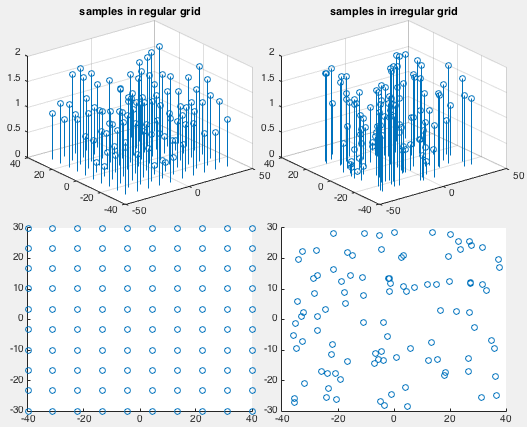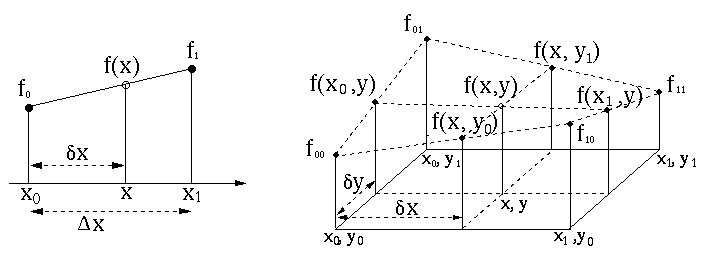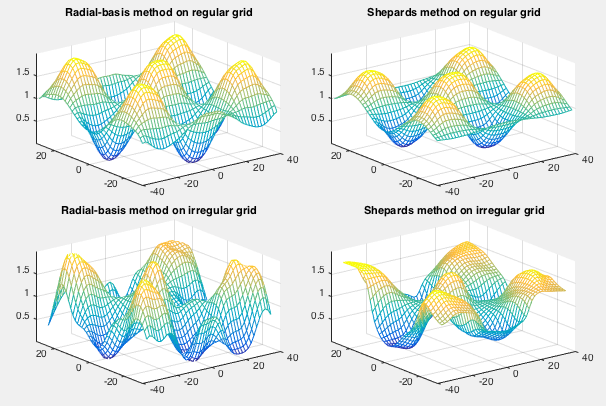Next: Regression Analysis and Classification Up: Interpolation and Extrapolation Previous: Cubic Spline Interpolation
Interpolation can also be carried out in 2-D space. Given a set of
sample points

![${\bf x}_i=[x_i,y_i]^T$](img412.svg)


Methods based on sample points in regular grid
Given a set of 2-D sample points in a regular grid, we can use the methods
of bilinear and bicubic 2-D interpolation to obtain the value of the
interpolating function 










First recall that 




 i.e. i.e. |

This method of 1-D linear interpolation can be extended to the
bilinear interpolation method to calculate the function value







 |
 |
 |
|
 |
 |
 |
 |
 |
![$\displaystyle \frac{dy}{\Delta y}[f(x,y_1)-f(x,y_0)]+f(x,y_0)$](img439.svg) |
|
 |
![$\displaystyle \frac{dy}{\Delta y}
\left[\frac{\delta x}{\Delta x}(f_{11}-f_{01}...
...}(f_{10}-f_{00})-f_{00}\right]
+\frac{\delta x}{\Delta x}(f_{10}-f_{00})+f_{00}$](img440.svg) |
||
 |
 |
(98) |
As the final expression for the bilinear interpolation is symmetric with
respect to 

The same set of 2-D sample points can be more smoothly approximated by a bicubic function in the following form:
 |
 can be found by assuming
that at the four corners
can be found by assuming
that at the four corners  ,
,  ,
,  and
and  of the
rectangle in which
of the
rectangle in which  resides,
resides,  and
and  have the same
partial derivative values as well as function values:
have the same
partial derivative values as well as function values:
 |
![$\displaystyle {\bf A}{\bf a}=
\left[\begin{array}{cccccccccccccccc}
1 & 0 & 0 &...
...}(0,0)\\ f_{xy}(1,0)\\ f_{xy}(0,1)\\ f_{xy}(1,1)\end{array}\right]
={\bf f}
\\ $](img451.svg) |
![$\displaystyle {\bf a}={\bf A}^{-1}{\bf f}=
\left[\begin{array}{c}a_{00}\\ a_{10...
...\\
f_{xy}(0,0)\\ f_{xy}(1,0)\\ f_{xy}(0,1)\\ f_{xy}(1,1)\end{array}\right]
\\ $](img452.svg) |

Methods based on sample points in irregular grid
The methods discussed above require the data points to be available on a regular (rectangular) grid. They do not work if the data points are hileramdomly scattered in the 2-D space (irregular grid). We now discuss methods that work for both regular and irregular grids.
A radial basis function (RBF) is any function that is centrally
symmetric with respect to a specific point
![${\bf x}_0=[x_0, y_0]^T$](img453.svg)
![${\bf x}=[x,\,y]^T$](img454.svg)



 |
 is a parameter that controls the width of the RBF.
By adjusting
is a parameter that controls the width of the RBF.
By adjusting  we can achieve the desired smoothness of the
interpolating function based on the density of the scatter data
points (average distance between any two points). The parameter
we can achieve the desired smoothness of the
interpolating function based on the density of the scatter data
points (average distance between any two points). The parameter  in the Butterworth function is the order of the function which controls
the shape of the function
in the Butterworth function is the order of the function which controls
the shape of the function

Based on a given RBF



 |
 are determined based on the requirement that the interpolating
function takes the same value as the sample point at each of the
are determined based on the requirement that the interpolating
function takes the same value as the sample point at each of the  positions:
positions:
 |
 linear equations with
linear equations with  coefficients
coefficients
 , we get the weights
, we get the weights
 and
thereby the interpolation function
and
thereby the interpolation function
 .
.
In this method, the value of the interpolating function


 |
 is the weight function that is inversely proportional
the pth power of the distance
is the weight function that is inversely proportional
the pth power of the distance
 between
between  and
and  , and normalized:
, and normalized:
 |
 . Here the parameter
. Here the parameter  controls
the rate of decay of
controls
the rate of decay of
 as the
distance
as the
distance
 becomes greater. Similar to the parameter
becomes greater. Similar to the parameter
 in the RBF method, here
in the RBF method, here  can also be adjusted according the
density of the sample points to control the smoothness of the interpolating
function
can also be adjusted according the
density of the sample points to control the smoothness of the interpolating
function
 .
.
In particular, at any sample point

 |
 |
 |
The weight function


 |
 for all
for all
 . To do so, we
can set
. To do so, we
can set
 (a very large number in practicd) when
(a very large number in practicd) when
 , so that
, so that
 . and
. and
 for all
for all
 .
.
